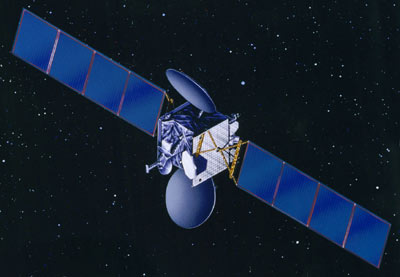Thank you very much for visiting Gunter's Space Page. I hope that this site is useful and informative for you.
If you appreciate the information provided on this site, please consider supporting my work by making a simple and secure donation via PayPal. Please help to run the website and keep everything free of charge. Thank you very much.
PAS 6B → Intelsat 6B

PAS 6B [Boeing BSS]
In March 1998, Hughes Space and Communications Company of El Segundo, Calif., was selected by PanAmSat Corporation of Greenwich, Conn., to build PAS-6B, a Hughes HS-601HP spacecraft model to provide direct-to-home television transmissions in South America. The satellite was launched Dec. 21, 1998.
As a Hughes HS-601HP, PAS-6B carries the latest technological advancements in satellites: dual-junction gallium arsenide solar cells and a xenon ion propulsion system. The solar array on PAS-6B generates 8 kilowatts of power. The xenon ion propulsion system, "XIPS," is 10 times more efficient than the propulsion systems currently in use and enables the satellite to carry more payload.
The 7-kilowatt payload consists of 32 Ku-band transponders that are powered by a combination of 105 watt and 140 watt traveling-wave tube amplifiers. Designed to provide a minimum of 15 years of service, PAS-6B is the fourth Hughes 601HP to serve PanAmSat.
Intelsat changed the name of the PAS satellites to Intelsat effective to 1. February 2007.
In 2003 PAS 6B lost the secondary XIPS engines additionally to the earlier loss of the primaries, which wil lead to a reduced lifetime.
| Nation: | USA |
|---|---|
| Type / Application: | Communication |
| Operator: | PanAmSat |
| Contractors: | Hughes / Boeing |
| Equipment: | 32 Ku-band transponders |
| Configuration: | HS-601HP |
| Propulsion: | R-4D-11-300, 4 × XIPS-13 ion engines |
| Power: | 2 deployable solar arrays, batteries |
| Lifetime: | 15 years |
| Mass: | 3470 kg |
| Orbit: | GEO |
| Satellite | COSPAR | Date | LS | Launch Vehicle | Remarks | |
|---|---|---|---|---|---|---|
| PAS 6B → Intelsat 6B | 1998-075A | 22.12.1998 | Ko ELA-2 | Ariane-42L H10-3 |
References:
- Boeing: PAS-6B
